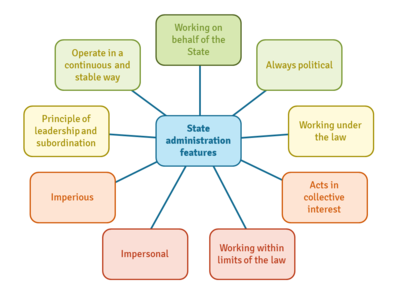State administration
From CEOpedia | Management online
| State administration |
|---|
| See also |
State administration is defined as a system of entities created by statute and in the competence to carry out internal and external management and executive activities with responsibility assigned to state.
Features of state administration
- administration is working on behalf and in name of the State,
- administration is always political,
- administration is working under the law and within the limits set by it,
- administration must act in the collective interest,
- administration is working under the competence granted by law,
- administration is impersonal,
- administration is imperious,
- administration operates on the principle of leadership and subordination,
- administration is a team of people, who are professional staff,
- administration must operate in a continuous and stable way.
Bodies of public administration in state
State administration bodies due to the territorial scope of the actions can be divided into:
- supreme authorities,
- central authorities,
- local authorities.
Supreme authorities of the public administration
They have the following characteristics:
- are appointed by the President (either directly or after the election by the Parliament),
- issue commands to other bodies,
- have the constitutional and political responsibility.
Central authorities of public administration
The central authorities of the administration operate on the basis of the relevant laws and statutes of the Council of Ministers by.
Local public administration authorities
Local public administration in the province are:
- governor, voivode, complex steering departments, inspection and guard offices,
- regional and local authorities.
See also:
References
- Gray, A., & Jenkins, B. (1995). From public administration to public management: reassessing a revolution?. Public administration, 73(1), 75-99.
